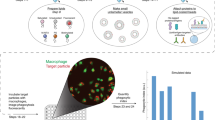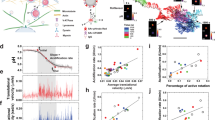Abstract
Secretion of lysosomes and related organelles is important for immune system function. High-resolution membrane capacitance techniques were used to track changes in membrane area in single phagocytes during opsonized polystyrene bead uptake and release. Secretagogue stimulation of cells preloaded with beads resulted in immediate vesicle discharge, visualized as step increases in capacitance. The size of the increases were consistent with phagosome size. This hypothesis was confirmed by direct observation of dye release from bead-containing phagosomes after secretagogue stimulation. Capacitance recordings of exocytosis were correlated with quantal free radical release, as determined by amperometry. Thus, phagosomes undergo regulated secretion in macrophages, one function of which may be to deliver sequestered free radicals to the extracellular space.
This is a preview of subscription content, access via your institution
Access options
Subscribe to this journal
Receive 12 print issues and online access
$209.00 per year
only $17.42 per issue
Buy this article
- Purchase on Springer Link
- Instant access to full article PDF
Prices may be subject to local taxes which are calculated during checkout







Similar content being viewed by others
References
Huber, L. A., Madison, D. L., Simons, K. & Pfeiffer, S. E. Myelin membrane biogenesis by oligodendrocytes: Developmental regulation of low molecular weight GTP-binding proteins. FEBS Lett. 347, 273–278 (1994).
Tapper, H. The secretion of preformed granules by macrophages and neutrophils. J. Leukocyte Biol. 59, 613–622 (1996).
Tjelle, T., Saigal, B. & Berg, M. F. Degradation of phagosomal components in late endocytic organelles. J. Cell Sci. 111, 141–148 (1998).
Desjardins, M., Nzala, N., Corsini, R. & Rondeau, C. Maturation of phagosomes is accompanied by changes in their fusion properties and size-selective acquisition of solute materials from endosomes. J. Cell Sci. 110, 2303–2314 (1997).
Hampton, M. B., Kettle, A. J. & Winterbourn, C. C. Inside the neutrophil phagosome: oxidants, myeloperoxidase, and bacterial killing. Blood 92, 3007–3017 (1998).
Andrews, N. W. Regulated secretion of conventional lysosomes. Trends Cell Biol. 10, 316–321 (2000).
Rodriguez, A., Webster, P., Ortego, J. & Andrews, N. W. Lysosomes behave as Ca2+-regulated exocytic vesicles in fibroblasts and epithelial cells. J. Cell Biol. 137, 93–104 (1997).
Reddy, A., Caler, E. V. & Andrews, N. W. Plasma membrane repair is mediated by Ca(2+)-regulated exocytosis of lysosomes. Cell 106, 157–169 (2001).
Ninomiya, Y., Kishimoto, T., Miyashita, Y. & Kasai, H. Ca2+-dependent exocytotic pathways in Chinese hamster ovary fibroblasts revealed by a caged-Ca2+ compound. J. Biol. Chem. 271, 17751–17754 (1996).
Martinez, I. et al. Synaptotagmin VII regulates Ca(2+)-dependent exocytosis of lysosomes in fibroblasts. J. Cell Biol. 148, 1141–1149 (2000).
Silverstein, R. L. & Febbraio, M. Identification of lysosome-associated membrane protein-2 as an activation-dependent platelet surface glycoprotein. Blood 80, 1470–1475 (1992).
Hirano, T. et al. Apical secretion of lysosomal enzymes in rabbit pancreas occurs via a secretagogue regulated pathway and is increased after pancreatic duct obstruction. J. Clin. Invest. 87, 865–869 (1991).
Diakonova, M. et al. Localization of fine annexins in J774 macrophages and on isolated phagosomes. J. Cell Sci. 110, 1199–1213 (1997).
Hackam, D. et al. v-SNARE-dependent secretion is required for phagocytosis. Proc. Natl Acad. Sci. USA 95, 11691–11696 (1998).
Holevinsky, K. O. & Nelson, D. J. Membrane capacitance changes associated with particle uptake during phagocytosis in macrophages. Biophys. J. 75, 2577–2586 (1998).
Di, A., Krupa, B. & Nelson, D. J. Calcium-G protein interactions in the regulation of macrophage secretion. J. Biol. Chem. 276, 37124–37132 (2001).
Campos-Toimil, M., Edwardson, J. M. & Thomas, P. Real-time studies of zymogen granule exocytosis in intact rat pancreatic acinar cells. J. Physiol. 528 Pt 2, 317–326 (2000).
Suzaki, E., Kobayashi, H., Kodama, Y., Masujima, T. & Terakawa, S. Video-rate dynamics of exocytotic events associated with phagocytosis in neutrophils. Cell Motil. Cytoskeleton 38, 215–228 (1997).
Breckenridge, L. J. & Almers, W. Final steps in exocytosis observed in a cell with giant secretory granules. Proc. Natl Acad. Sci. USA 84, 1945–1949 (1987).
Privat, C. et al. Superoxide release from interleukin-1B-stimulated human vascular cells: in situ electrochemical measurement. Free Rad. Biol. Med. 27, 554–559 (1999).
Hackam, D. J. et al. Characterization and subcellular localization of target membrane soluble NSF attachment protein receptors (t-SNAREs) in macrophages. J. Immunol. 156, 4377–4383 (1996).
Martin, F., Salinas, E., Vazquez, J., Soria, B. & Reig, J. A. Inhibition of insulin release by synthetic peptides shows that the H3 region at the C-terminal domain of syntaxin-1 is crucial for Ca(2+)- but not for guanosine 5′-[gamma-thio]triphosphate-induced secretion. Biochem. J. 320 (Pt 1), 201–205 (1996).
Chen, D., Bernstein, A. M., Lemons, P. P. & Whiteheart, S. W. Molecular mechanisms of platelet exocytosis: role of SNAP-23 and syntaxin 2 in dense core granule release. Blood 95, 921–929 (2000).
Fujiwara, T., Yamamori, T. & Akagawa, K. Suppression of transmitter release by Tat HPC-1/syntaxin 1A fusion protein. Biochim. Biophys. Acta 1539, 225–232 (2001).
DeLeo, F. R. & Quinn, M. T. Assembly of the phagocyte NADPH oxidase: molecular interaction of oxidase proteins. J. Leuk. Biol. 60, 677–691 (1996).
DeLeo, F. R., Allen, L. A., Apicella, M. & Nauseef, W. M. NADPH oxidase activation and assembly during phagocytosis. J. Immunol. 163, 6732–6740 (1999).
Halliwell, B. & Gutteridge, J. M. Oxygen free radicals and iron in relation to biology and medicine: some problems and concepts. Arch. Biochem. Biophys. 246, 501–514 (1986).
Delon, J. & Germain, R. N. Information transfer at the immunological synapse. Curr. Biol. 10, R923–R933 (2000).
Delon, J. The immunological synapse. Curr. Biol. 10, R214 (2000).
Stinchcombe, J. C., Bossi, G., S., B. & Griffiths, G. M. The immunological synapse of CTL contains a secretory domain and membrane bridges. Immunity 15, 751–761 (2001).
Bajjalieh, S. SNAREs take the stage: a prime time to trigger neurotransmitter secretion. Trends Neurosci. 24, 678–680 (2001).
Bajno, L. et al. Focal exocytosis of VAMP3-containing vesicles at sites of phagosome formation. J. Cell Biol. 149, 697–705 (2000).
Neher, E. The influence of intracellular calcium concentration on degranulation of dialysed mast cells from rat peritoneum. J. Physiol. (Lond.) 395, 193–214 (1988).
Alverez de Toledo, G. & Fernandez, J. M. Compound versus multigranular exocytosis in peritoneal mast cells. J. Gen. Physiol. 95, 397–409 (1990).
Hansen, N., Antonin, W. & Edwardson, J. Identification of SNAREs involved in regulated exocytosis in the pancreatic acinar cell. J. Biol. Chem. 274, 22871–22876 (1999).
Creutz, C. E. The annexins and exocytosis. Science 258, 924–931 (1992).
Nelson, D. J., Jacobs, E. R., Tang, J. M., Zeller, J. M. & Bone R.C. Immunoglobulin G-induced single ionic channels in human alveolar marcrophage membranes. J. Clin. Invest. 76, 500–507 (1985).
Naren, A. P., Quick, M., W., Collawn, J. F., Nelson D. J. & Kirk, K. L. Syntaxin 1A inhibits CFTR chloride channels by means of domain-specific protein–protein interactions. Proc. Natl Acad. Sci. USA 95, 10972–10977 (1998)
Hamill, O. P., Marty, A., Neher, E. & Sakmann, B. Improved patch-clamp techniques for high resolution current recording from cells and cell-free membrane patches. Pflugers Arch. Eur. J. Physiol. 391, 85–100 (1981).
Gillis, K. Admittance-based measurement of membrane capacitance using the EPC-9 patch-clamp amplifier. Pflugers Arch. Eur. J. Physiol. 439, 655–664 (2000).
Segura, F., Brioso, M. A., Gomez, J. F., Machado, J. D., & Borges, R. Automatic analysis for amperometrical recordings of exocytosis. J. Neurosci. Methods 103, 151–156 (2000).
Vasioukhin, V., Bauer, C., Yin, M. & Fuchs, E. Directed actin polymerization is the driving force for epithelial cell–cell adhesion. Cell 100, 209–219 (2000).
Marklund, S. Spectrophotometric study of spontaneous disproportionation of superoxide anion radical and sensitive direct assay for suuperoxide dismutase. J. Biol. Chem. 251, 7504–7507 (1976).
Acknowledgements
This work was supported by NIH/NIGMS R01 GM36823 to DJN, and the University of Chicago DDRCC (DK42086).
Author information
Authors and Affiliations
Corresponding author
Ethics declarations
Competing interests
The authors declare no competing financial interests.
Supplementary information
Movie 1
J774.1 macrophage cell loaded with polystyrene beads and quinacrine. All quinacrine-loaded vesicles were typically discharged within 20 sec of HAIGG addition. Numbers adjacent to the vesicles mark denote sequence of quinacrine-stained vesicle release. (AVI 1628 kb)
Movie 2
The surface plane of a J774.1 macrophage cell pre-loaded with polystyrene beads shown following HAIGG application. Beads are observed to rise to the surface over a time course of 128 sec. Arrows mark appearance of beads with time at the cell surface.view). (AVI 1935 kb)
Rights and permissions
About this article
Cite this article
Di, A., Krupa, B., Bindokas, V. et al. Quantal release of free radicals during exocytosis of phagosomes. Nat Cell Biol 4, 279–285 (2002). https://doi.org/10.1038/ncb771
Received:
Revised:
Accepted:
Published:
Issue Date:
DOI: https://doi.org/10.1038/ncb771
This article is cited by
-
Three-dimensional distribution of TrkA neurotrophin receptors in neurite varicosities of differentiated PC12 cells treated with NGF determined by immunoelectron tomography
Cell and Tissue Research (2013)
-
Vesicular and conductive mechanisms of nucleotide release
Purinergic Signalling (2012)
-
Differential effects of ceramide species on exocytosis in rat PC12 cells
Experimental Brain Research (2007)



